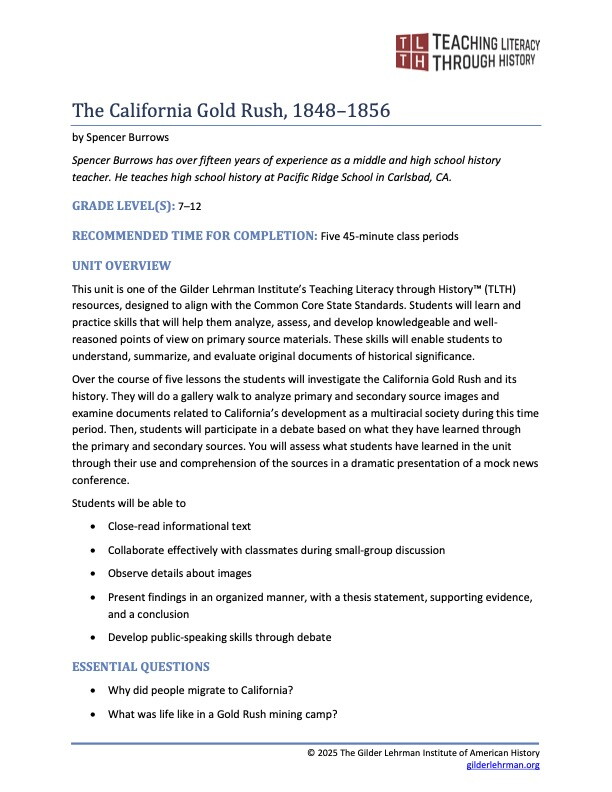Lesson by Spencer Burrows
Essay by Elliott West, University of Arkansas
Grade Level: 7–12
Number of Class Periods: 5
Primary Era: National Expansion and Reform, 1815–1860

Over the course of five lessons the students will investigate the California Gold Rush and its history. They will do a gallery walk to analyze primary and secondary source images and examine documents related to California’s development during this time period. Then, students will participate in a scripted debate based on what they have learned through the primary and secondary sources.
Lesson Plan Author: Spencer Burrows
Historical Background Essay by Elliott West, University of Arkansas
CCSS.ELA-LITERACY.RH.9-10.4: Determine the meaning of words and phrases as they are used in a text, including vocabulary describing political, social, or economic aspects of history/social science.
CCSS.ELA-LITERACY.RI.7.1: Cite several pieces of textual evidence to support analysis of what the text says explicitly as well as inferences drawn from the text.
CCSS.ELA-LITERACY.RI.7.2: Determine two or more central ideas in a text and analyze their development over the course of the text; provide an objective summary of the text.
CCSS.ELA-LITERACY.RI.11-12.1: Cite strong and thorough textual evidence to support analysis of what the text says explicitly as well as inferences drawn from the text, including determining where the text leaves matters uncertain.
CCSS.ELA-LITERACY.RI.11-12.5: Analyze and evaluate the effectiveness of the structure an author uses in his or her exposition or argument, including whether the structure makes points clear, convincing, and engaging.
CCSS.ELA-LITERACY.SL.9-10.1: Initiate and participate effectively in a range of collaborative discussions (one-on-one, in groups, and teacher-led) with diverse partners on grades 9-10 topics, texts, and issues, building on others’ ideas and expressing their own clearly and persuasively.
CCSS.ELA-LITERACY.W.9-10.1: Write arguments to support claims in an analysis of substantive topics or texts, using valid reasoning and relevant and sufficient evidence.
Why did people migrate to California?
What was life like in a Gold Rush mining camp?
What contributed to a sense of lawlessness in the Gold Rush-era mining camps, boomtowns, and the city of San Francisco?
What types of people lived in California between 1848 and 1856?
“James Marshall, Discoverer of Gold, at Sutter’s Mill,” Coloma, California, ca. 1850, a reproduction of a daguerreotype by R. H. Vance
Message from James K. Polk to the Two Houses of Congress, December 5, 1848
“Gold and Quicksilver District of California” map and headlines from “El Dorado of the United States of America,” California Herald, December 26, 1848
James Buchanan’s Advice on Travel to California to an unknown recipient, February 5, 1849
Map from Hosea B. Horn, Horn’s Overland Guide, from the US Indian Subagency, Council Bluffs, on the Missouri River, to the City of Sacramento, in California, New York: J. H. Colton, 1852
Broadside by James M. Hutchings, Hutchings’ California Scenes.—Methods of Mining, San Francisco, 1855
Lettersheet by Harrison Eastman and Ben Kutcher, artists, and Anthony & Baker, engraver, The Miner’s Ten Commandments, San Francisco: Sun Print, 1853
“Abe Warner’s Cobweb Palace, a Saloon (formerly a butcher shop) Built 1856,” San Francisco, n.d., Roy D. Graves Pictorial Collection, UC Berkeley
Henry Bacon, “The Luck of Roaring Camp,” Harper’s Weekly, May 7, 1881
Engraving from a lettersheet by Charles Christian Nahl, artist, and Anthony & Baker, engraver, “A Road Scene in California,” Wide West Office, San Francisco, 1856
“Foreign Miners Tax,” Daily Alta California, March 7, 1851
Joseph B. Starkweather, “Head of Auburn Ravine,” 1852